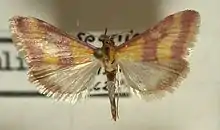Pyrausta sanguinalis
Pyrausta sanguinalis, the scarce crimson and gold, is a moth of the family Crambidae. The species was first described by Carl Linnaeus in his 1767 12th edition of Systema Naturae. It is found across western Europe as far east as southern Finland. In the British Isles it was formerly found at multiple coastal locations in north-west England and Scotland, however it has now much declined and it is restricted to a few locations in Northern Ireland and a single site on the Isle of Man.
| Pyrausta sanguinalis | |
|---|---|
 | |
.jpg.webp) | |
| Scientific classification | |
| Kingdom: | Animalia |
| Phylum: | Arthropoda |
| Class: | Insecta |
| Order: | Lepidoptera |
| Family: | Crambidae |
| Genus: | Pyrausta |
| Species: | P. sanguinalis |
| Binomial name | |
| Pyrausta sanguinalis | |
| Synonyms | |
| |
The wingspan is 14–18 mm. The moth flies from June to August depending on the location.
The larvae feed on common sage, rosemary and thyme.
External links
- "Pyrausta sanguinalis (Linnaeus, 1767)". Catalogue of the Lepidoptera of Belgium. Archived from the original on 1 April 2012.
- Kimber, Ian. "63.004 BF1364 Pyrausta sanguinalis (Linnaeus, 1767)". UKMoths. Retrieved 10 December 2020.
| Wikimedia Commons has media related to Pyrausta sanguinalis. |
This article is issued from Wikipedia. The text is licensed under Creative Commons - Attribution - Sharealike. Additional terms may apply for the media files.
